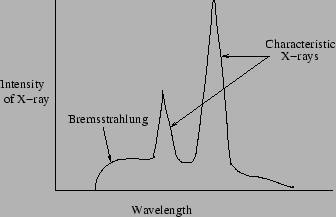
 |
Characteristic X-rays are produced through inner shell electron transitions in atoms. Characteristic X-rays are discrete in wavelengths. Different elements present in a substance can be identified using X-ray diffraction which will show the X-ray peaks at particular wavelengths. Accelerated or decelerated electrons produce continuous X-rays (Bremsstrahlung ). When a metal target is fired with electrons both Characteristic X-rays of the metal are produced with continuous Bremsstrahlung background.
Since the wavelengths of the X-rays are of atomic dimensions or less they are good probes for finding the structures of substances. Human body is transparent for X-rays but the bones are not. 10-100 KeV X-rays are used for diagnostic purpose to locate fractures etc.
Hot ionized gas (plasma) found in many astrophysical situations like around our sun or around black holes also produces X-ray. Figure 9.6 shows the Centaurus cluster, a cluster of galaxies more than hundred in number as seen in the optical image on the left. The X-ray image of the same cluster shown on the right reveals that in addition to the galaxies there is a hot ionized gas at a temperature of few tens of million Kelvin which emits copious amounts of X-ray.
Inner shell electronic transitions in atoms also produce X-ray. X-ray is also produced in particle accelerators like the synchrotron.